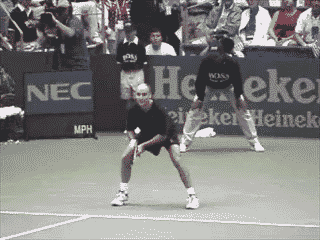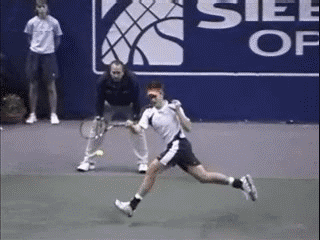| |
|
|
4.
Linear
Linear power is the body moving behind the line of the ball in the direction of
the shot. |
 |
| |
|
 |
Not only is power gained by the body following the line of the ball but it can
also be gained by the racket flattening out behind the ball. |
| |
|
|
5.
Rebound
Another source of power that is not often talked about is the use of one’s
opponents pace as it rebounds off the racket. |
 |
| |
|
 |
Using an opponent’s pace effectively is one of the attributes that
separate top level players.
Agassi on this return of serve has almost no backswing and is
relying on linear arm and rebound power – using the pace of the
serve against his opponent. |
| |
|
|
It is interesting how you can use the understanding of the forces and directions
of power to help modify technique.
My first example shows how the importance of the midcourt ball can be
explained. It is the one area of the court where a player can bring nearly
every power into play and maximise most of them. |
| |
|
|
The player now explodes off the ground following
the line of the ball for maximum use of groundforce and linear
body power. |
 |
|
He can flatten out the shot for maximum linear racket/arm power
and also explode the hips and arm with powerful rotation.
You would also expect the
player to take the ball on at the top of the bounce using whatever speed the
opponent has imported for some rebound power as well.
You can quickly deduce what
needs to change if, for instance, the player is imparting too much vertical
racket power and ‘fizzing’ the ball short with excessive topspin.
|
|
 |
|
Ask the player to deliver more linear racket force and less
vertical. Seeing the different powers as a graphic equaliser,
which can tune up or tune down the different powers is an
excellent aid to learning technique.
|
|
A second example of a player running laterally along the
baseline clearly defines which force will be the most dominant.
|
 |
| |
|
ANSWER: UPWARD
ROTATIONAL POWER
|
|
Clearly there is no linear body force, no groundforce, possibly
one ball length of linear arm/racket, some rebound help so the
major power source is vertical power in the form of upward
rotational power.
|
 |
|
This is an additional
tool to help learn and modify technique by deciding which powers
you can utilise and how they change the way you hit the ball by
increasing or decreasing the different powers. |
| |
|
|
The following graphs
show how we can use graphics in a way to explain modifying
techniques by changing different power sources
|
 |
 |
|
The above graphic shows an optimum midcourt ball being struck
with maximum groundforce, almost no upward rotational power,
good rotational yet not maximum, maximum linear body and linear
arm/racket power and because the ball will be slow limited
rebound power. |
Highlighting differences, eg not getting off the ground, will
offer a great visual to a player of what needs to be done.
|
|
The only limits to how much you can use the directions of power
is your imagination. Young players in particular easily relate
to the idea of increasing or decreasing certain powers. |